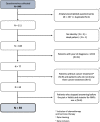Cancer patients' behaviors and attitudes toward natural health products
- PMID: 38057795
- PMCID: PMC10698981
- DOI: 10.1186/s12906-023-04278-0
Cancer patients' behaviors and attitudes toward natural health products
Abstract
Background: Natural health products (NHPs), including vitamins, minerals, and herbal supplements, are the most common complementary and alternative medicine (CAM) among cancer patients. Our survey determined the attitudes and behaviors of cancer patients toward natural complementary therapies that should be considered to implement an integrative approach in the future.
Methods: Our survey was conducted in four hospitals in Belgium. Questionnaires were posted online from October 2020 to October 2021 for cancer patients. Descriptive statistics were used to analyze the data. A [Formula: see text] test was applied to study the type of NHP consumed according to diagnosis time. Fischer's exact test compared patients who had changed their consumption since diagnosis and those who had not.
Results: Out of 349 questionnaires collected, only 59 met all inclusion criteria. 83.1 % of the patients agreed that conventional medicine (CM) could benefit from complementary therapies, but they did not estimate (72.3 % of the patients) that those latter are more effective than conventional medicine. More than half of the patients used five or more NHPs. The most frequent NHPs consumed daily were vitamins (64.4 %), followed by other products (i.e., probiotics, gemmotherapy, birch sap and omega 3/6) (42.4 %) and herbs (40.7 %). Almost all patients started taking NHPs before their cancer diagnosis, but 72.7 % have changed their consumption significantly (p = 0.009) since their diagnosis. Boosting the immune system (79.7 %) and limiting conventional treatment side effects (76.9 %) were the most common reasons for NHPs' use. 74.4 % of the patients did not take complementary therapies to delay or avoid conventional treatment.
Conclusions: The combination and high diversity of NHPs consumption highlight the importance of educating patients and healthcare providers (HCPs) about the risk of drug interactions associated with these natural products. Most cancer patients are more interested in using this non-mainstream medicine to complement their conventional treatment than as an alternative. Knowing the patients' reasons and understanding patients' attitudes toward NHPs will be essential for HCPs to address NHPs' use.
Keywords: Attitudes; Behaviors; Belgium; Cancer; Complementary and alternative medicine; Descriptive study; Integrative oncology; Natural health products; Online questionnaire.
© 2023. The Author(s).
Conflict of interest statement
The authors declare no competing interests.
Figures
Similar articles
-
Public awareness, patterns of use and attitudes toward natural health products in Kuwait: a cross-sectional survey.BMC Complement Altern Med. 2014 Mar 19;14:105. doi: 10.1186/1472-6882-14-105. BMC Complement Altern Med. 2014. PMID: 24646341 Free PMC article.
-
Pediatric natural health products recommended by chiropractic and naturopathic doctors in Canada.Complement Ther Med. 2019 Apr;43:196-200. doi: 10.1016/j.ctim.2019.02.001. Epub 2019 Feb 4. Complement Ther Med. 2019. PMID: 30935530
-
Self-reported use of natural health products: a cross-sectional telephone survey in older Ontarians.Am J Geriatr Pharmacother. 2009 Dec;7(6):383-92. doi: 10.1016/j.amjopharm.2009.12.003. Am J Geriatr Pharmacother. 2009. PMID: 20129259
-
A strategy for controlling potential interactions between natural health products and chemotherapy: a review in pediatric oncology.J Pediatr Hematol Oncol. 2007 Jan;29(1):32-47. doi: 10.1097/MPH.0b013e3180310521. J Pediatr Hematol Oncol. 2007. PMID: 17230065 Review.
-
Complementary and alternative medicine in urology.BJU Int. 2005 Dec;96(8):1177-84. doi: 10.1111/j.1464-410X.2005.05931.x. BJU Int. 2005. PMID: 16285876 Review.
Cited by
-
Natural Health Products for Anti-Cancer Treatment: Evidence and Controversy.J Pers Med. 2024 Jun 26;14(7):685. doi: 10.3390/jpm14070685. J Pers Med. 2024. PMID: 39063939 Free PMC article. Review.
-
Bridging the gap: attitudes and practices toward complementary and alternative medicine among oncology patients and healthcare professionals in Croatia.Front Psychol. 2025 Jan 29;16:1531111. doi: 10.3389/fpsyg.2025.1531111. eCollection 2025. Front Psychol. 2025. PMID: 39981396 Free PMC article.
-
Comparing Perspectives on Traditional and Complementary Medicine Use in Oncology: Insights from Healthcare Professionals and Oncology Patients in Western Mexico.Curr Oncol. 2025 Jan 28;32(2):71. doi: 10.3390/curroncol32020071. Curr Oncol. 2025. PMID: 39996871 Free PMC article.
-
Cancer Patients' Behavior and Perception on the Use of Medical Foods and Dietary Supplements During Chemotherapy.Patient Prefer Adherence. 2025 May 9;19:1385-1395. doi: 10.2147/PPA.S514170. eCollection 2025. Patient Prefer Adherence. 2025. PMID: 40370472 Free PMC article.
References
-
- Complementary, Alternative, or Integrative Health: What’s In a Name? [web page]; 2021. https://www.nccih.nih.gov/health/complementary-alternative-or-integrativ.... Accessed 25 Jan 2023.
-
- Micke O, Bruns F, Glatzel M, Schönekaes K, Micke P, Mücke R, et al. Predictive factors for the use of complementary and alternative medicine (CAM) in radiation oncology. Eur J Integr Med. 2009;1(1):19–25. doi: 10.1016/j.eujim.2009.02.001. - DOI
MeSH terms
Substances
LinkOut - more resources
Full Text Sources
Medical
Miscellaneous








